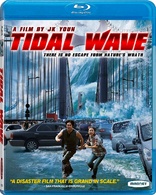Tidal Wave Blu-ray Movie
HomeTidal Wave Blu-ray Movie 
HaeundaeMagnolia Pictures | 2009 | 110 min | Rated R | May 11, 2010
Movie rating
6.1 | / 10 |
Blu-ray rating
| Users | 4.5 | |
| Reviewer | 3.0 | |
| Overall | 3.7 |
Overview
Tidal Wave (2009)
Located on the southeast tip of the Korean peninsula is the international city of Busan. A popular vacation spot on the East Sea coast, Haeundae draws one million visitors to its beaches every year. Man-sik, a native of Haeundae, lost a co-worker to a tsunami on a deep-sea fishing trip four years ago. He has never returned to sea ever since. He now leads a simple life running a small seafood restaurant and is preparing to propose to his longtime girlfriend, Yeon-hee. Man-sik’s brother Hyung-sik works as a coast guard. One day, he rescues a female college student from Seoul who promptly, comes on to him aggressively. While these everyday domestic affairs unfold, geologist Kim Hwi, an expert on tsunami research, discovers the East Sea is showing signs of activity similar to the Indian Ocean at the time of the 2004 tsunami. Despite his warnings, the Disaster Prevention Agency affirms that Korea is in no harm of being hit. When he discovers a mega-tsunami is headed straight for the Korean peninsula, he quickly heads down to Haeundae. There he meets up with his ex-wife, who is organizing a cultural event, for the first time in seven years. He also sees his young daughter who is unaware that he is her father. Eventually, Kim gets a call about a deadly oncoming wave, with only ten minutes to spare! While the vacationers and citizens of Busan are enjoying a peaceful, hot summer day, a mega-tsunami is headed straight for Haeundae at 500 miles per hour.
Starring: Sul Kyung-gu, Ha Ji-won, Park Joong-hoon, Lee Min-ki, Kang Ye-wonDirector: JK Youn
| Foreign | Uncertain |
| Drama | Uncertain |
| Action | Uncertain |
| Thriller | Uncertain |
Specifications
Video
Video codec: VC-1
Video resolution: 1080p
Aspect ratio: 2.35:1
Original aspect ratio: 2.39:1
Audio
Korean: DTS-HD Master Audio 5.1
English: DTS-HD Master Audio 5.1
Subtitles
English, English SDH, Spanish
Discs
50GB Blu-ray Disc
Single disc (1 BD)
BD-Live
Playback
Region A, B (C untested)
Review
Rating summary
| Movie | 3.0 | |
| Video | 4.0 | |
| Audio | 4.0 | |
| Extras | 3.0 | |
| Overall | 3.0 |
Tidal Wave Blu-ray Movie Review
Korea’s first disaster movie nearly drowns in frothy melodrama.
Reviewed by Casey Broadwater May 23, 2010Really, what’s left for the disaster film? The genre started small, with 1901’s Fire!, in which firemen attempt to rescue the inhabitants of a single burning house, and 109 years later we have Roland Emmerich’s 2012, which shows mass destruction on a global scale. In between, we’ve had the atomic-inspired b-movie monsters of the 1950s, the “golden age” of Irwin Allen- produced disaster flicks in the ‘70s, and a resurgence of the genre in the late ‘90s and early ‘00s, with blockbuster extravaganzas like Armageddon, The Perfect Storm, and The Day After Tomorrow. By this point, we’ve seen it all—earthquakes, volcanoes, asteroids, even global warming—so the only thing that differentiates new disaster films from an entire century of predecessors is the style in which they’re told and the personal, character-driven stories that they tell. Tidal Wave (a.k.a. Haeundae) is Korea’s first big disaster movie—though you could make a case for 2006’s The Host—and it largely apes the conventions and clichés of every Hollywood destruction film in the past 50 years. The only difference is that Tidal Wave combines the expected large-scale CGI theatrics with characters and situations straight out of a Korean soap opera, the heightened emotions and literally looming disaster creating some seriously sudsy melodrama.
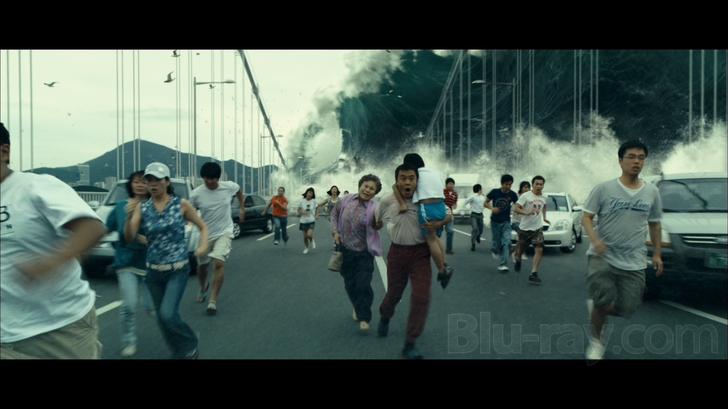
Yeah, good luck trying to outrun the 300-foot-tall wave.
Director Yoon Je-kyoon, who previously helmed Sex is Zero—the Korean answer to bawdy teen comedies like American Pie—moves into more Spielbergian territory here, but he’s overly ambitious in his attempt to deliver big thrills and even bigger emotions. Those looking for non-stop action may want to steer their ship to another cinematic port of call, as Tidal Wave’s titular tsunami doesn’t occur until nearly an hour and a half into the film. Pre- disaster, we find ourselves lost in a nebulous web of characters and conflicts, all carefully arranged to ensure maximum emotional payoff once couples and families are tearfully separated or joyously reunited. There are no less than three pairs of star-crossed/tsunami-parted lovers in Tidal Wave, and the story cuts back and forth between their narrative threads, occasionally—and conveniently—intertwining them.
The central protag is Man-sik (Sol Kyung-gu), a former fisherman who, during the 2004 tsunami, survived a shipwreck that killed the father of his beautiful long-time admirer Yeon-hee (Ha Ji-won), who runs a kind of illegal seaside sushi restaurant. As Man-sik feels responsible for the death, he’s never considered Yeon-hee as a love interest, but of course, that’s all about to change. Yes, right in time for a 300-foot-tall mega-tsunami. The second coupling consists of Man-sik’s brother, stuttering lifeguard Hyeong-sik (Lee Min-ki), and Hee-mi (Kang Ye-won), the uptown college student that he rescued from drowning. Early on, their relationship is played largely for laughs— he’s the bumbling country kid, she’s the glitzy, yacht-riding sophisticate—but Heong-sik’s eventual stiff-lipped heroics turn Tidal Wave, ever so briefly, into a loose remake of the Kevin Costner Coast Guard drama The Guardian. Finally, every disaster film needs an expert, the guy whose warnings about imminent danger go unheeded by those in power. Here, it’s geologist and tsunami scientist Kim Hwi (Park Joong-hoon), who finds himself in a position to save his ex-wife (Uhm Jung-hwa) and their young daughter. Naturally, in a plot device taken straight out of Jaws, government officials don’t want to evacuate Haeundae Beach, a popular summer tourist spot, for fear of disrupting business revenue.
And these are only the main storylines. A large cast of subsidiary characters factor into the plotting as well, from an elderly businessman trying to build a shopping complex on the waterfront— turning a tiny coastal village into a tourist trap—to a shrieking grandma, a lazy-ass uncle, and a kid with a loose tooth. Unlike many disaster films, which toss a group of random strangers together to deal with mother nature’s fury, with little to no character development, Tidal Wave makes an earnest attempt at crafting individuals that we’ll care about once all of Poseidon’s rage breaks loose. And to some extent, it works; we do get to know these characters and their troubles, big and small, but the film has trouble striking a consistent tone. Many of the early scenes play like broad comedy, with physical gags and over-the-top dialogue. Then, overcompensating in the last half, the mood goes saccharine and bleary-eyed, with a few too many Titanic moments (i.e., lovers losing a grip on one another’s hands). To be fair, massive disasters do involve bigger than life emotions, but Tidal Wave lingers too long on these beats, throwing off the rhythm of the action.
Still, there are some genuinely gripping action sequences to be found in Tidal Wave if you’re patient enough to wait for them. No, the CGI isn’t up to Hollywood standards—it’s a bit too clean, too obviously artificial—but the disaster is directed with a breakneck intensity that sells the illusion well. The tidal wave is triggered by a massive earthquake beneath a Japanese island, and is it rises up some three hundred feet into the air, the director places his camera—well, his point of view within the CGI software—right on top of the breaker, surfer-like. In the city streets, pedestrians scramble to avoid the inevitable as the wave looms overhead. A giant tanker is upheaved and comes to rest vertically against a suspension bridge; when it explodes, cargo containers crash into buildings across the bay. An electrical box falls into the water, violently electrocuting everyone within range. Skyscrapers are flooded, trapping women in bathroom stalls and elevators. It’s not too little, but it does come too late. Once the water starts to recede, a bigger disaster strikes: more melodrama.
Tidal Wave Blu-ray Movie, Video Quality 
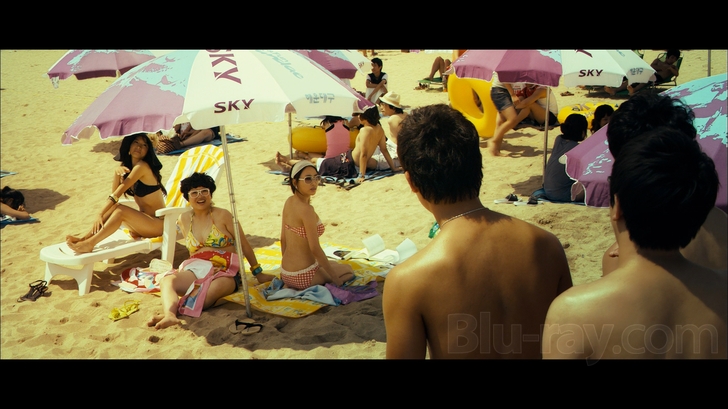
Tidal Wave crashes onto Blu-ray with a 1080p/VC-1 encoded transfer that handles the film's slightly stylized visuals wonderfully. IMDB.com errantly lists the movie as being shot on 35mm, but if you watch the making of documentary included in the bonus features, you'll see that high definition digital cameras were actually used—hence the film's clean, grain-free, and nearly noiseless image. Clarity is quite strong throughout, allowing us to make out individual strands of hair, small beads of water, fine facial texture, and the smallest details on clothing and props. Just as impressive are the film's vivid color reproduction and pushed contrast. Many of the early scenes feature a kind of emulated cross-processed look—with a yellowish cast and ultra-saturated colors—and as the impending disaster draws closer, the film's palette gets darker and bleaker, though no less visually intense. Blacks are deep throughout, and while the heated contrast sometimes crushes shadow detail, this seems intentional and does give the image a dramatic and dimensional presence. As you'd expect, the CGI isn't up to par with Hollywood standards—some of the composites look plainly artificial—but the effects are impressive considering the film's comparatively small budget. I was able to suspend my disbelief, anyway. Compression and post-production blemishes are almost entirely absent.
Tidal Wave Blu-ray Movie, Audio Quality 

So, what exactly does a mega-tsunami sound like? As few who have been close enough to hear have survived to tell, the sound designers for Tidal Wave had quite a task. Ultimately, what they came up with is incredibly effective—a mounting LFE-heavy rumble with a touch of spray—and this disc's Korean DTS-HD Master Audio 5.1 surround track is as dynamic and all-encompassing as you'd hope. The rear channels frequently swell with activity, especially during the last half of the film, in which gurgles, splashes, and crashing waves surround you almost constantly. There some impressive cross-channel effects too, like helicopters moving seamlessly from one corner of the soundfield to another, and water splashing every which way. In both the effects and the orchestral score, bass is deep and defined, and there's plenty of high-end detail. Like most foreign language releases by Magnolia, the disc defaults to an English dub, but unless you're the sort that simply can't stand to read subtitles, you'll want to switch over to the much more authentic and emotionally accurate Korean mix. I've heard worse English voiceovers, but no matter how good the dub job is, it's never quite the same. Dialogue is reproduced clearly in both tracks, however, and subtitles are available in easy to read white lettering.
Tidal Wave Blu-ray Movie, Special Features and Extras 
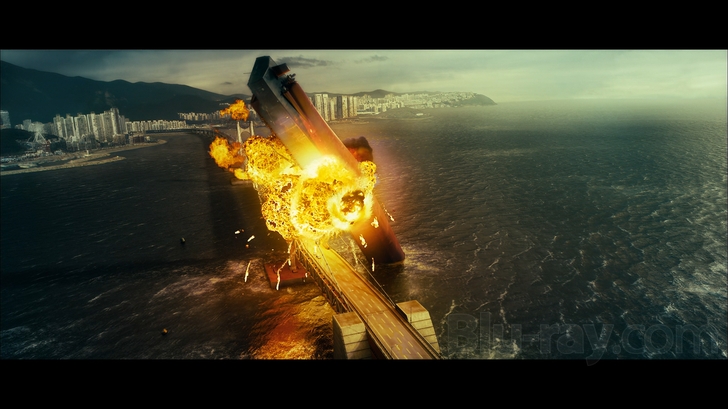
Deleted Scenes (SD, 13:20)
Includes about ten deleted scenes, most of them additional character-developing beats.
Gag Reel (SD, 5:53)
You've gotta love a gag reel that starts with a child accidentally getting punched in the
face.
The Project (SD, 9:37)
Director Je-Kyun Youn, screenwriter Hwi Kim, co-producer Sang Yong Lee and others explain the
origins of the project and some of the challenges of filming a "big" film on a comparatively small
budget.
The Making of Tidal Wave (45:05)
A comprehensive making-of documentary, complete with loads on-set footage and interviews with
just about everyone involved.
Characters (SD, 5:40)
Here, some of the main actors say a few words about their characters.
Production Design (SD, 6:52)
In this featurette, the film's production designer discusses how his crew figured out how to build
their sets around a dilapidated pool.
Musical Score (SD, 6:11)
Composer Byung Woo Lee talks about the process of writing the score.
Sound Mixing Part 1 (SD, 4:25)
I'm not sure why this is broken into two short segments, but here the director and sound designer
discuss the difficulty of figuring out what a tsunami should actually sound like.
Sound Mixing Part 2 (SD, 9:02)
In part 2, the film's lead sound designer shows us exactly how the sounds for certain scenes were
mixed.
Marketing (SD, 11:35)
Yes, even marketing gets its own featurette, with PR pros discussing how their main job was
convince the public not only that a Korean director could helm a disaster film, but that a disaster
like this could actually happen in Korea.
CG Special Effects (1080i, 23:11)
VFX supervisor Sung-ho Chang and others discuss the creation of the film's many special effects
showpieces.
Cinematography (1080i, 10:50)
The cinematographer and editor talk about the film's color toning and process of shooting digitally,
while before/after images play on the screen.
Also From Magnolia Home Entertainment Blu-ray (1080p, 6:22)
Includes trailers for Red Cliff, District 13: Ultimatum, and The Warlords,
along with a promo for HDNet.
BD-Live Functionality
Bookmarks
Tidal Wave Blu-ray Movie, Overall Score and Recommendation 
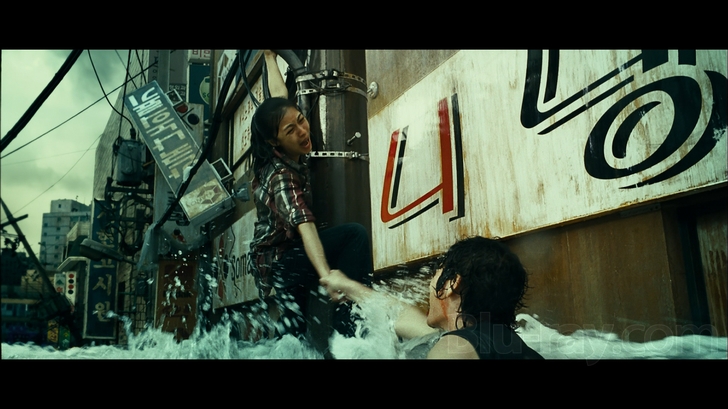
Korea's first big disaster film stays afloat thanks to decent effects and a genuinely gripping second half, but it does have a millstone around its neck in the form of weepy familial melodrama, the sort that's so soppy your brain—like fingers in a bathtub—might begin to prune. Asian film fans and disaster movie aficionados may find repeat viewing potential here, but for all others this is a solid rental for a weekday afternoon.
Similar titles
Similar titles you might also like

The Tower
2012

Emergency Declaration
비상선언 / Bisang Seoneon
2021

The Wave
Bølgen
2015

The Quake
Skjelvet
2018

Force Majeure
Turist
2014

Ashfall
백두산
2019

The Burnt Orange Heresy
2019

The Stool Pigeon
綫人 / Sin yan
2010

Lifeline 4K
Shí wàn huǒ jí / 十萬火急
1997

Escape from Mogadishu
모가디슈 / Mogadisyu
2021

The Bouncer
2018

Ponette
1996

A Fantastic Woman
Una mujer fantástica
2017

The Fool
Дурак / Durak
2014

Kameradschaft
Comradeship
1931

Let the Corpses Tan
Laissez bronzer les cadavres
2017

Goto, Isle of Love
Goto, l'île d'amour
1969

Early Spring
早春
1956

The Naked Island
裸の島 / Hadaka no shima
1960

Hands Over the City
Le mani sulla città
1963
